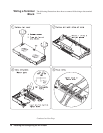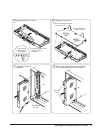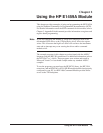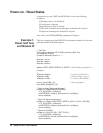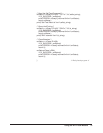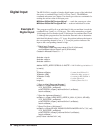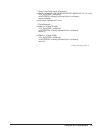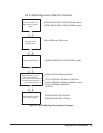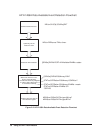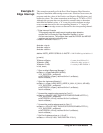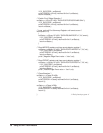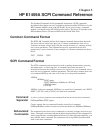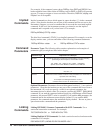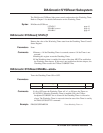
34 Using the HP E1459A Module
Edge Detected Event Detection
The HP E1459A can respond to two types of events: Edge Events (either
negative edge, positive edge, or both) and Data Available. Figures 2-1 and
2-2 show the general flow of commands necessary to program the HP
E1459A to detect events. Figure 2-1 shows the flow for Edge Event
Detection, Figure 2-2 shows the flow for Data Available Event Detection.
Three general methods of identifying and servicing an HP E1459A detected
event are:
• Polling the Port Summary Register
• Polling the VXI Status Subsystem
• SRQ Interrupt
When an Edge Event occurs, read the value of the port(s) with the
[SENSe:]EVENt:PORTn:NEDGe? or [SENSe:]EVENt:PORTn:PEDGe?
command. When a Data Available Event occurs, read the value of the port(s)
with the
MEASure:DIGital:DATAn command.
Polling the Port
Summary Register
The first, and easiest method, is to repeatedly poll the Port Summary
Register using either the
SENSe:EVENt:PSUMmary:EDGE? command (for
Edge Events) or the
SENSe:EVENt:PSUMmary:DAVailable? command (for
Data Available Events) until an event occurs. Example 3 in this chapter
demonstrates this procedure.
Polling the Status
Subsystem
The second method is to set-up and repeatedly poll the Status Subsystem.
You can poll the port summary condition register with the
STATus:OPERation:PSUMmary:CONDition? command to determine when
an event has occurred.
Alternately, set-up the port summary enable register to specify the type of
event(s) and port(s) to monitor; use the
STATus:OPERation:PSUMmary:ENABle<
mask
> command. Then enable
bit 9 in the Status Operation Enable register; use the
STATus:OPERation:ENABle command. Repeatedly poll the module with
the *
STB? command to determine when bit 7 becomes set.
SRQ Interrupt The third method is to set-up the Status Subsystem and have the HP E1459A
Module interrupt (via SRQ) the system computer when an event occurs. In
general, you must set-up the port summary enable register to specify the type
of event(s) and port(s) to monitor; use the
STATus:OPERation:PSUMmary:ENABle<
mask
> command. Then, enable
bit 9 in the Status Operation Enable register; use the
STATus:OPERation:ENABle command. Enable the OPR bit (bit 7) in the
Status Register with the
*SRE 128 command; this allows the Operation
Status register to generate the SRQ.



